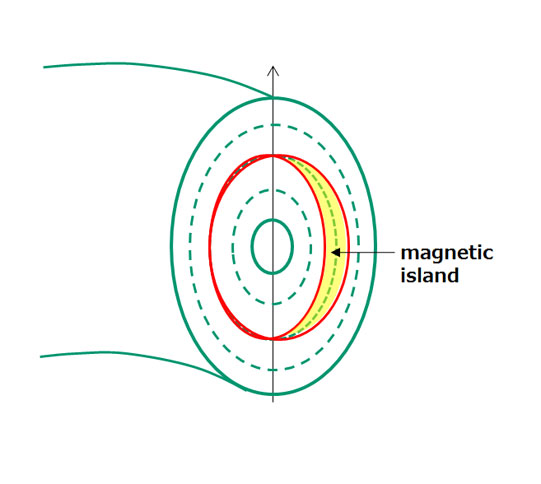HOME > Research Activities > Research Updates >
A Comparison of Helical and Tokamak Plasmas
An aurora dancing brightly in the evening sky is beautiful. An aurora is a plasma in the natural world, but the artificial plasma employed in fusion energy generation must be confined by utilizing a magnetic field container. However, when attempting to confine a plasma inside the magnetic field container numerous particles inside the plasma mingle together and a “fluctuation” is generated both in the plasma and the magnetic field. When an aurora moves it is beautiful. But in a plasma used for fusion energy generation, when fluctuations grow and become large it is no longer possible to confine the plasma. For that reason, investigating the properties of the plasma fluctuations is an important research issue. Here, we will introduce recent observation results in which the fluctuation grows larger at the same time that rotation decelerates.
In a plasma confined in the Large Helical Device (LHD) magnetic field, when a fluctuation is generated, in many cases that fluctuation is keeping the constant amplitude and rotating at a constant speed. Whether the fluctuation will grow or not is influenced by the shape of the magnetic field container. The shape of the magnetic field container is determined by the combination of the electric currents flowing from the electromagnets outside the plasma. When we purposefully construct an “unstable” magnetic field container in which fluctuations will grow greatly, as the rotation speed of fluctuations begins to fall the fluctuation grows, and when the rotation stops the phenomenon in which a fluctuation grows greatly is observed. Further, in the result it is indicated that the plasma pressure (production of temperature and particle density) quickly falls. Such a phenomenon is very similar to the phenomenon that was observed earlier in the tokamak experimental device (below as tokamak).
In a tokamak, when a fluctuation’s rotation stops, suddenly a phenomenon that will become unstable called “locked instability” appears. The cause of the fluctuation’s halt, that is, “to become locked,” is thought to be the “irregular magnetic field” born in the case in which the precision of the installation of the electromagnets is imperfect. Actually, the place where “the irregular magnetic field” exists is where the rotation of the fluctuation has a tendency to stop. Further, fluctuations that are observed in a tokamak have structures that form “magnetic islands.” The cross section of an ideal magnetic field container, like tree rings, becomes a concentric circle in a nested state. Due to the fluctuation, the magnetic field’s container becomes frayed, and the magnetic island having a crescent-shaped structure sometimes appears (please see the figure). Such a magnetic structure grows through being connected to the “irregular magnetic field,” and it is thought that the plasma can no longer be maintained. Such an instability has been predicted not to be regularly generated in a helical-type experimental device in which electrical current does not flow, unlike in a tokamak. For that reason, that the “locked instability” was observed in the LHD was a great surprise. What exactly had happened was a riddle.
In order to solve this riddle, we are examining in detail the fluctuation’s structure and its temporal evolution. According to recent diagnostic results, we have learned that even in the LHD it is possible for a fluctuation to at the least have the structure of a magnetic island before becoming locked. We are advancing actively in both theoretical and experimental research regarding when and in what conditions a fluctuation that is considered not to produce a magnetic island changes to a structure that has a magnetic island. Because such instabilities are generated only when conducting an experiment in a special magnetic field container, we can avoid the instabilities by optimizing the shape of the container. Further, even in a special magnetic container, if we can stabilize fluctuations by undertaking some sort of control that does not stop the rotation of a plasma, then we will be able to maintain the temperature and density of plasma in various types of magnetic field containers, and we will be able to expand the area of the future fusion reactor design. Through comparisons of observation results in a tokamak, we will advance our research in understanding the qualities of fluctuations generated in a helical plasma and in seeking to establish control methods.

Normally, the magnetic field container has a nested shape. However, when there is an irregular magnetic field, that field takes the shape of a crescent, as shown in the image.
